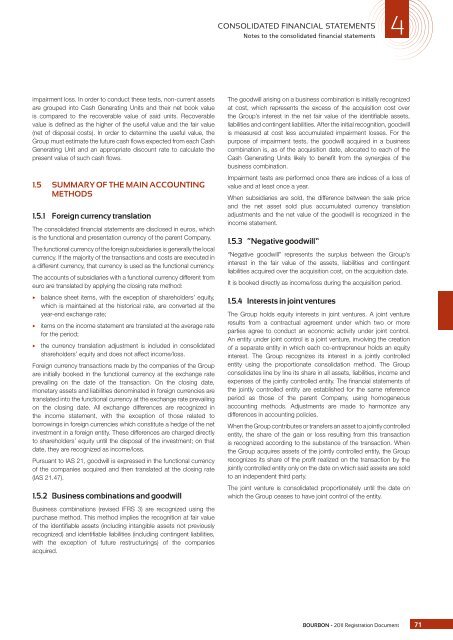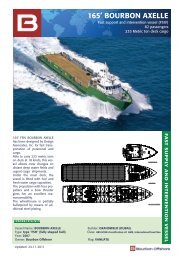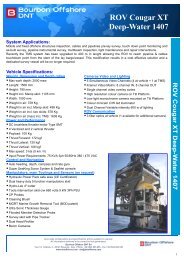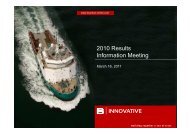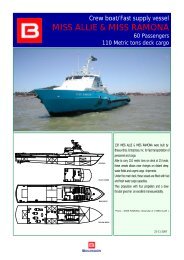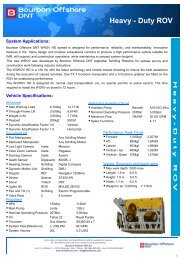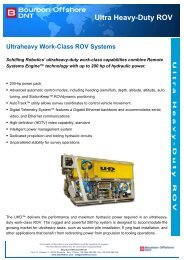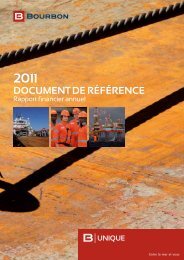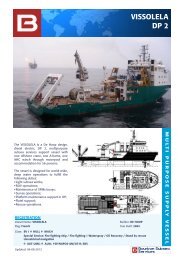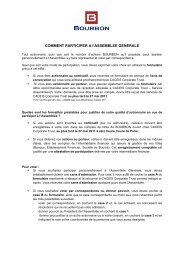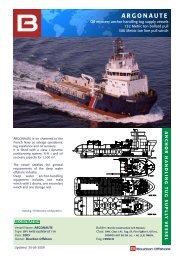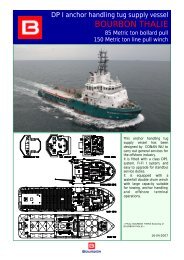REGISTRATION DOCUMENT - Bourbon
REGISTRATION DOCUMENT - Bourbon
REGISTRATION DOCUMENT - Bourbon
- No tags were found...
Create successful ePaper yourself
Turn your PDF publications into a flip-book with our unique Google optimized e-Paper software.
CONSOLIDATED FINANCIAL STATEMENTS4Notes to the consolidated financial statementsimpairment loss. In order to conduct these tests, non-current assetsare grouped into Cash Generating Units and their net book valueis compared to the recoverable value of said units. Recoverablevalue is defi ned as the higher of the useful value and the fair value(net of disposal costs). In order to determine the useful value, theGroup must estimate the future cash fl ows expected from each CashGenerating Unit and an appropriate discount rate to calculate thepresent value of such cash fl ows.1.5 SUMMARY OF THE MAIN ACCOUNTINGMETHODS1.5.1 Foreign currency translationThe consolidated fi nancial statements are disclosed in euros, whichis the functional and presentation currency of the parent Company.The functional currency of the foreign subsidiaries is generally the localcurrency. If the majority of the transactions and costs are executed ina different currency, that currency is used as the functional currency.The accounts of subsidiaries with a functional currency different fromeuro are translated by applying the closing rate method:3 balance sheet items, with the exception of shareholders’ equity,which is maintained at the historical rate, are converted at theyear-end exchange rate;3 items on the income statement are translated at the average ratefor the period;3 the currency translation adjustment is included in consolidatedshareholders’ equity and does not affect income/loss.Foreign currency transactions made by the companies of the Groupare initially booked in the functional currency at the exchange rateprevailing on the date of the transaction. On the closing date,monetary assets and liabilities denominated in foreign currencies aretranslated into the functional currency at the exchange rate prevailingon the closing date. All exchange differences are recognized inthe income statement, with the exception of those related toborrowings in foreign currencies which constitute a hedge of the netinvestment in a foreign entity. These differences are charged directlyto shareholders’ equity until the disposal of the investment; on thatdate, they are recognized as income/loss.Pursuant to IAS 21, goodwill is expressed in the functional currencyof the companies acquired and then translated at the closing rate(IAS 21.47).1.5.2 Business combinations and goodwillBusiness combinations (revised IFRS 3) are recognized using thepurchase method. This method implies the recognition at fair valueof the identifi able assets (including intangible assets not previouslyrecognized) and identifi able liabilities (including contingent liabilities,with the exception of future restructurings) of the companiesacquired.The goodwill arising on a business combination is initially recognizedat cost, which represents the excess of the acquisition cost overthe Group’s interest in the net fair value of the identifi able assets,liabilities and contingent liabilities. After the initial recognition, goodwillis measured at cost less accumulated impairment losses. For thepurpose of impairment tests, the goodwill acquired in a businesscombination is, as of the acquisition date, allocated to each of theCash Generating Units likely to benefi t from the synergies of thebusiness combination.Impairment tests are performed once there are indices of a loss ofvalue and at least once a year.When subsidiaries are sold, the difference between the sale priceand the net asset sold plus accumulated currency translationadjustments and the net value of the goodwill is recognized in theincome statement.1.5.3 “Negative goodwill”“Negative goodwill” represents the surplus between the Group’sinterest in the fair value of the assets, liabilities and contingentliabilities acquired over the acquisition cost, on the acquisition date.It is booked directly as income/loss during the acquisition period.1.5.4 Interests in joint venturesThe Group holds equity interests in joint ventures. A joint ventureresults from a contractual agreement under which two or moreparties agree to conduct an economic activity under joint control.An entity under joint control is a joint venture, involving the creationof a separate entity in which each co-entrepreneur holds an equityinterest. The Group recognizes its interest in a jointly controlledentity using the proportionate consolidation method. The Groupconsolidates line by line its share in all assets, liabilities, income andexpenses of the jointly controlled entity. The fi nancial statements ofthe jointly controlled entity are established for the same referenceperiod as those of the parent Company, using homogeneousaccounting methods. Adjustments are made to harmonize anydifferences in accounting policies.When the Group contributes or transfers an asset to a jointly controlledentity, the share of the gain or loss resulting from this transactionis recognized according to the substance of the transaction. Whenthe Group acquires assets of the jointly controlled entity, the Grouprecognizes its share of the profi t realized on the transaction by thejointly controlled entity only on the date on which said assets are soldto an independent third party.The joint venture is consolidated proportionately until the date onwhich the Group ceases to have joint control of the entity.BOURBON - 2011 Registration Document 71


